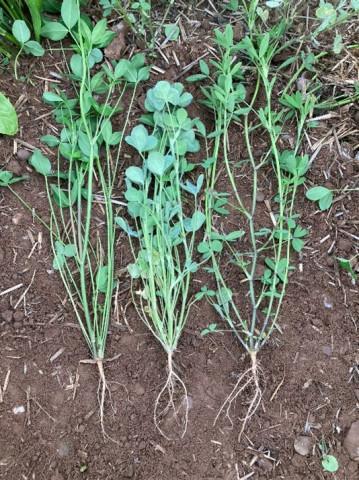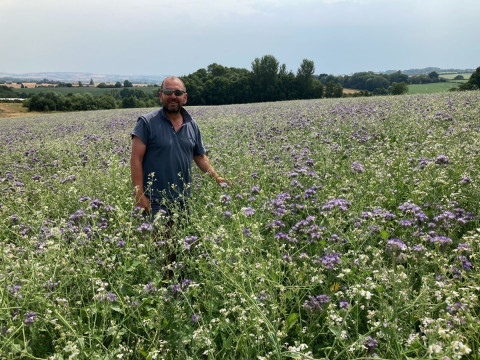The use of catch and cover crops
Today, there's more emphasis on sustainable, environmentally friendly crop production systems. As a result, cover and catch crops are becoming a widely understood and embraced method for aiding soil health.
The aim of cover and catch crops is to capture the nutrients that would otherwise be lost post-harvest and to return it into the soil. The importance of this for the longevity of future land management cannot be underestimated. As soil quality continues to decline year-on-year, it effects the soil's input requirements and crop production potential.
The importance of soil health
Last year, Kings technical advisor, Jim Egan wrote a blog about the role catch and cover crops play in soil management. The advice still stands today but with the focus on sustainability constantly evolving, I thought I'd summarise the key points ahead of the new season.
A valuable natural asset
Soils with low organic matter (OM) and poor structure are at risk of erosion, and any subsequent loss of vital soil, minerals and nitrates can be costly to the environment and farming businesses. Tied to this is how valuable OM is for carbon capture, as well as improving natural water systems like rivers and streams to support farm biodiversity. All of these can be greatly impacted if soils are not well managed.
The benefits to both the environment and your business by having cover in place to help capture nutrients should not be underestimated.
A great way to understand the value of the biomass created is to do a fresh weight cut down of the green material through the winter months. The insight can demonstrate considerable monetary value in terms of nutrient capture, especially given current market prices for applied product.
Your local Kings advisor can explain this simple assessment in more detail and carry out fresh weight cut downs and analysis on your chosen mixture with you.
Improved productivity and land management
Linked to the point above, higher OM content can make soils easier to work at a shallower depth = less disturbance to protect soil fertility and structure. Compacted soils often require more aggressive management, for example having to plough the ground to create a seedbed.
Good soil management can also mean reduced workload and machinery reliance over time, encouraging a higher biomass soil with more natural nutrients. This can mean fewer applications of manmade substitutes, contributing to more cost effective and sustainable production systems.
Part of future policy and land management legislation
If we are to continue providing enough healthy produce for our growing populations, we need to ensure soils are resilient enough for the future.
The role of catch and cover crops in soil health features in the Environmental Land Management schemes and subsequently the Sustainable Farming Incentive (SFI).
You can learn how to build a baseline of your soils for the arable and horticultural soil standard within SFI in this blog by my colleagues Hannah Clarke and Jacob Duce.
The role of catch and cover crops in the rotation
Catch and cover crops are grown after the main cash crop has been harvested and live in the soil until the next one is drilled. This is roughly from August to February, during which time the plants develop root structures to bind the soil together, preventing damage during heavy or prolonged rain and low winter temperatures.
These roots also increase the mycorrhizal fungi present within soil, which attach themselves to the plant's roots to establish a secondary root system to gather nutrients and improve soil structure.
They are a great method for capturing carbon too – an element that we need to keep locked in our soils. Above ground, the catch or cover crop shelters the soil, smothering out weeds whilst capturing carbon dioxide and nitrogen from the air and feeding it back down to the microorganisms living in the soil. What had been an atmospheric carbon problem therefore becomes a soil carbon solution, achieved by keeping living plants in the soil for as much of the year as possible.
Catch and cover crops also offer a helping hand to nature's own soil engineer: the earthworm. Their characteristics and numbers help improve soil habitat, so the number of earthworms should be monitored before and after catch or cover crops are introduced.
As well as working below ground, cover crops can be a great way to increase pollinators and predatory insect numbers that help with IPM (integrated pest management) across the landscape.
Successful establishment
Time and perseverance are key. Catch and cover crops provide long-term improvements to the farming system; they're an investment into your soil quality rather than an overnight fix. Although the crop gets to work from the outset, it can take a couple of years to reap the full benefits but you're already setting yourself in good stead for the future.
I recommend getting your crop in the ground right behind the combine. Catch and cover crops sown in late August to early September don't tend to perform as well and can have limited success as a result. However, moisture will be key.
With soil moisture often at its lowest during harvest time, especially this year, it should be protected at all costs. Whether you're establishing your crops via direct drilling or after lightly cultivating and then drilling, rolling should follow swiftly afterwards. I recommend drilling rather than broadcasting the seed so you ensure optimum seed-to-soil contact.
Choosing your mixture
Catch and cover crop mixes can have various purposes and comprise several species, ranging from the likes of rye and oats, to species like radish and chicory. There are mixtures that include all of these, as well as species like phacelia, vetch and sainfoin. Our Super 10 Mix is a great example.
For soil health I recommend our Kings Soil Structure Mix. It's designed to add large volumes of OM and contains deep rooting species to improve structure. More information can be found on page 18 in our Environmental Land Management and Specialist Crops catalogue.
Consider your following crop
You'll need make sure that your choices of straights or mixtures of catch and cover crops will not conflict with the next cash crop or a grazing potential. An agronomy plan will help you incorporate them while considering the risks and benefits that certain plant types will bring to that environment and rotation. This is where our Cereal-Free Mix comes into its own.
Incorporating livestock
The use of straights as catch crops can offer grazing potential during late winter months, for example stubble turnips or a turnip rape like Jupiter. If a faster rotation is needed for autumn, Avalon (when established after harvest) makes a fantastic catch crop that can be grazed off six weeks after planting and ahead of a winter cash crop establishment. This method is known as 'double cropping'.
Double cropping can also be when another straight like forage rye is drilled after harvest and foraged in the spring ahead of drilling a crop like maize. This helps to maximise production whilst maintaining a living root structure within the soil through the winter months.
Sowing after early harvest
With combines rolling much earlier than anticipated, it's time to consider your cover and catch crop requirements to maximise the benefits of soil cover over the later summer/autumn.
It's also important to note that not all cover/catch crops are used solely through the winter. Our Kings Summer Legume Mix is good for land that will be left bare through the spring/summer and will work in the same way to protect and improve the soil.
Summary
If you're contemplating a more regenerative approach, consider the use of cover and catch crops. The benefits to soil can be significant over a long-period, and should be seen as a valuable investment for the future of your soil's health and resilience. More than anything it is not the method that is hard to change, but the mindset.
If you'd like more advice on the management of catch and cover crops, please contact your Kings advisor, email This email address is being protected from spambots. You need JavaScript enabled to view it..uk or call our free technical helpline on 0800 587 9797.
As a subscriber, you’ll receive email alerts each time a new blog is published so you can always stay updated with the latest advice and insights from our experts







Comments